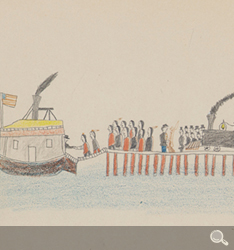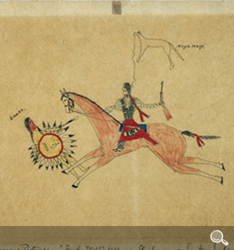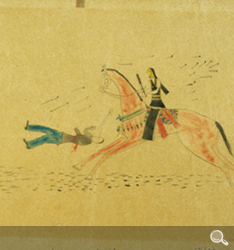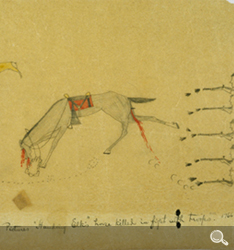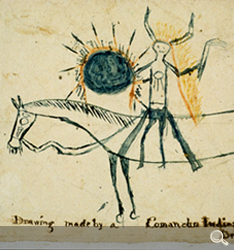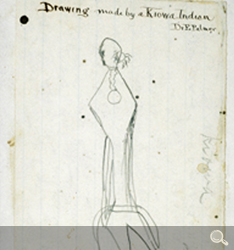

Ledger Drawings
Nineteenth-century Plains Indian drawings have often been called “ledger” drawings because they were made with pencil, ink, and watercolor on pages of old ledger or account books. When young Plains warriors learned to draw in this new style, the pictures they made were incorporated into the war-honors system of Plains life. The men then memorialized their deeds in pictures that they used with their oral recollections of bravery and battle, victory and loss.
Some of the best-known “ledger” art was created at Fort Marion, in Saint Augustine, Florida. Between 1875 and 1878, seventy-two Cheyenne, Kiowa, Comanche, Arapaho, and Caddo men were imprisoned there because of their involvements in events connected to the Red River Wars in Indian Territory (later Oklahoma). Encouraged to draw by their military captors, twenty-six of the prisoners, mostly Cheyenne and Kiowa, produced hundreds of drawings and a number of books detailing their former lives as warriors, hunters, and suitors as well as their new lives as prisoners and students.
The Bear's Heart Ledger Book Bear’s Heart, Southern Tsitsistas/Cheyenne, about 1875, signed by artist Courtesy National Museum of the American Indian. This book of twenty-four drawings prepared by Bear’s Heart, one of the Fort Marion prisoners of war, was given by Richard Henry Pratt to William Tecumseh Sherman.
"Transfer from Cars to Steamboat at Jacksonville, May 21, 1875" Bear’s Heart, Southern Tsitsistas-Cheyenne, about 1875 Courtesy National Museum of the American Indian
"Cheyenne Pictures. High Wolf Kills a Shoshonee or Snake Indian." Unknown artist, about 1894 The mounted warrior, with name glyph “High Wolf,” appears as the central subject of this drawing. His victory over the falling Snake (Shoshone) warrior, identified by his shield, seems complete as he appears to ride over him with his arms extended. He is counting coup by touching his enemy with his riding quirt, or whip.
Cheyenne Picture. Warrior Killing a Soldier. Unknown artist, about 1894 The central message of this drawing is the victory of the Cheyenne warrior over a U.S. Army soldier. The warrior has counted coup, his quirt, or whip, having touched the head of the soldier. This event is described as occurring during a larger battle with many adversaries, indicated by the number of rifles at the left and the arrows and bullets flying.
Cheyenne Pictures. Standing Elk’s Horse Killed in Fight with Troops. Unknown artist, about 1894 The central focus of this image is a wounded horse, bleeding from head and rump, being fired on by U.S. troops at the right. Standing Elk, with his name glyph above him, has dismounted and appears to be safe from the rifle shots. The suggestion of concern by the warrior indicates the high value placed on horses by Plains tribesmen.
"Drawing made by a Kiowa Indian" Unknown artist, about 1868 This drawing of a Comanche warrior was likely prepared and collected in 1868 at the Kiowa and Comanche Agency in present-day Oklahoma. The artist’s representation of a warrior on horseback follows a tradition of pictographic imagery which presents the subject on one plane without the illusion of depth. Here both of the warrior’s legs and leg sashes are imaged on the viewer’s side of the horse.
"Drawing made by a Comanche Indian" Unknown artist, about 1868 This Kiowa Indian drawing was likely prepared and collected in 1868 at the Kiowa and Comanche Agency in present-day Oklahoma. Non-Indians were known to have offered paper and illustrating equipment to Plains Indians as early as thirty years earlier in order to inspire creative outlets. This drawing displays a Kiowa warrior’s head and neck ornament (possibly a peace medal), and his leg sashes.

